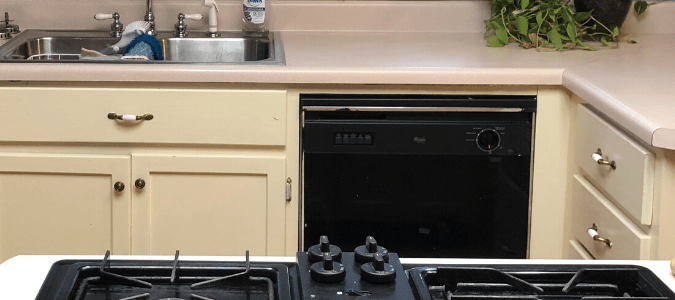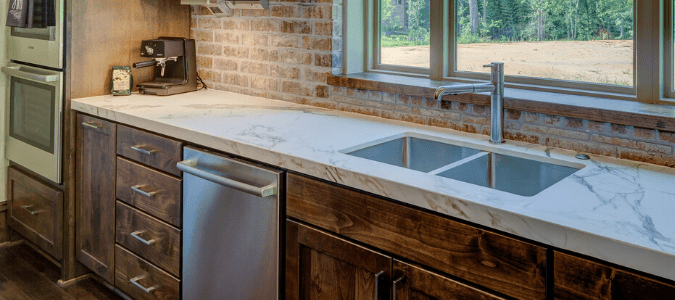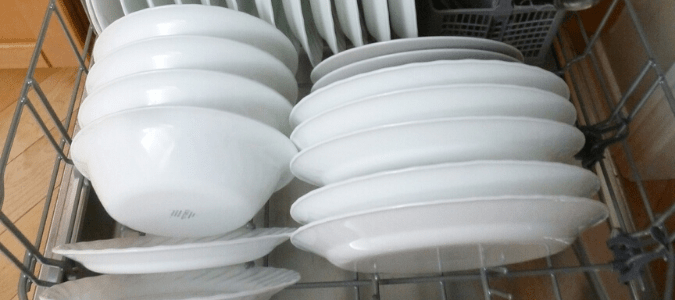
While cleaning up after dinner, you notice that a significant amount of water has accumulated in the bottom of your dishwasher. You know that a little water is normal, but this seems excessive. Before you tackle another load of dishes sitting in the sink, you may realize you don’t know how to unclog a dishwasher with standing water. You’re probably also wondering why this happened in the first place and how can you prevent it from happening again.
The most likely reason water is pooling in your dishwasher is that you have filters that have been become blocked because of food debris that has built up over time. Most newer models have manual-clean filters, unlike the self-cleaning filters that were more common in these units a decade ago. Clogged filters can prevent water from rising or draining, and can even make your dishes smell. Thankfully, cleaning your manual filters is relatively simple.
Before you get to work, unplug your dishwasher and remove as much standing water as you can. In order to take out the filter and get to the drain pump, you will most likely have to remove the sprayer arm. All dishwasher models are slightly different. Some sprayer arms come off easily, while others require a more involved disassembly. Keep your user’s manual nearby as you work on your dishwasher.
Once you get down to the filter screen, you’ll probably see some debris or other buildup. You can clean out the filter screen by rinsing it under your kitchen faucet or applying water with more force with a sink sprayer or garden hose. If debris is caked on, you may want to soak your filter in warm, soapy water. You may also need to wipe off any leftover residue. You can also use a soft sponge, but avoid harder brushes or steel wool. Excessive blockages or damage from cleaning too vigorously may create holes in the filter, which will allow clogging to move further into the dishwasher’s drainage system. Now that you know you’ll need to routinely clean out your filter, you can either set a reminder to do so, based on your specific make and model, or pay close attention to food that might remain stuck on your dishes after the wash cycle, since that’s an easy way to tell that it’s time to clean out the filter.
If food makes its way past your filters, there could be buildup in the drain pump or even further in the drain hose. The drain pump may be removed and cleaned with a garden hose. Use a drain snake in order to clean deeper parts of the drainage system or consider calling in a professional. You can also check for gunk or stuck items that might be clogged around your sink, too.
If you’ve made it this far and had success, you can put everything back together again. Once you’ve turned your unit back on, add a mixture of baking soda and vinegar to your empty dishwasher. Let the mixture sit for 10 minutes and run the dishwasher once. This mixture can help clean out the drainage system or interior of your dishwasher. Drain cleaning products are often too harsh and may cause harm to the drain hose and other parts of the appliance.
These do-it-yourself tips should help to address less serious cases of clogged dishwashers. However, if you run the dishwasher after removing debris and still find a large amount of standing water at the bottom of your appliance, the clog may be deeper in the dishwasher. If you find yourself in this scenario, it is probably time to reach out to an appliance repair specialist.
While many homeowners find they need to learn how to handle a dishwasher with standing water, there are other dishwasher problems that you may also come across. We’ll review many other common dishwasher issues, starting with what to do if your dishwasher won’t turn on.

Is There No Power To Your Dishwasher? Here’s What To Try
If your dishwasher isn’t getting any power, the first thing you want to check is very simple. Make sure that your dishwasher didn’t get unplugged. If your dishwasher is plugged in, make sure that the prongs fit snugly into the outlet. Also, you should be plugging your dishwasher directly into the outlet. Do not use an extension cord to plug your dishwasher in, as this can compromise the flow of electricity to your appliance. Lastly, make sure that if your dishwasher operates on a switch, that it was not flipped off inadvertently in your normal course of activities.
Next, you’ll want to go check on your circuit breaker. If your garbage disposal is humming, there’s a chance you tripped a breaker. If not, your next step will be to plug something else into your dishwasher’s outlet to make sure that you don’t have a faulty outlet. If the outlet seems to make the other device you plugged in work fine, you probably have a problem with your dishwasher. If not, you know your outlet is the problem.
If your problem is with your dishwasher, the next thing you may want to consider as the culprit for your issue is your internal wiring. Keep in mind, even with some experience, this can be a difficult task to troubleshoot, and often the best route to take is to contact an appliance repair specialist. If you decide to go the do it yourself route first, the first thing you’ll want to do is unplug the dishwasher from its power source. Next, remove the front control panel and take a look at the wiring. Does anything look corroded or broken? Check your door switch, which is the four wires that are connected with a piece of plastic. You may need to get a new door switch if any of these wires are no longer operating properly.
Maybe you got your dishwasher to turn on, yet it still won’t start. What’s going on in that case?

Is Your Dishwasher Not Starting? Troubleshooting Tips
If your dishwasher is not starting but you see that its lights are flashing, you may have accidentally pressed the start button more than once. By pressing the start button multiple times, you may have inadvertently reset your dishwasher, which may result in your appliance running a drain cycle for 90 seconds. Once that drain cycle is finished, press the start button just once and see if your dishwasher starts as it normally would.
If your dishwasher still isn’t working and you want to try to get it running again, make sure you didn’t accidentally turn on the child lock. Some dishwashers come with child locks to prevent kids from accidentally turning on the dishwasher when it doesn’t need to be on. You can check your owner’s manual to see if this is a setting your dishwasher has and if so, how to turn this setting off.
If you are still stumped, your problem is probably with one of the following parts:
- Door latch
- Timer or electronic control
- Selector switch
- Motor start relay
- Thermal fuse
If your issue is with one of these parts, you can use a multimeter to try to narrow down what’s wrong. Whenever you start working on the electrical components on a dishwasher, you want to start by unplugging your appliance from the outlet. This is will help protect you from injuries related to working with water and electricity.
First, make sure that your door latch is working properly. If the door latch on your dishwasher doesn’t close all the way, the appliance won’t start. To check this part, open your dishwasher door and locate the door switch at the top. Check that both of the switches are activated when the door closes. If everything looks good there, the next thing you’ll want to look at is your timer and electronic control. These parts regulate how much power is sent to each part of your dishwasher, including the drain pump, the heating circuit and the water inlet valve. If your timer and electronic control aren’t working properly, these parts may not receive the correct amount of power, or any power at all. You can use a multimeter to make sure power is running through these components, or contact an appliance repair specialist or electrician who can run the proper tests.
You will also need a multimeter to see if your motor start relay and thermal fuse are working. You can find the motor start relay right next to the motor. Check for continuity by testing the coil portion of the motor relay. If your motor start relay is working, move on to your thermal fuse. The thermal fuse is what sends power to the control board, therefore, a malfunctioning thermal fuse will result in a dishwasher that won’t start. To test the thermal fuse, open the access door panel and check the continuity of the two wires that are attached to it. If your thermal fuse is blown, it will need to be replaced.
Because working with dishwashers requires working with electricity and water, the safest and quickest way to resolve many dishwasher issues is to reach out to a specialist who knows all about the inner workings of these appliances.
Another common dishwasher problem is an appliance that isn’t getting any water.

If Your Dishwasher Is Not Getting Water, What Parts Could Be Malfunctioning?
Too much standing water at the end of the cycle is one problem. No water at all is a completely different issue. If the dishwasher is not filling up, you might have a problem with your water inlet valve, your float assembly, your float switch or your door switch.
Water Inlet Valve
The water inlet valve is the part that regulates the flow of water into the dishwasher. If your dishwasher’s filters are clogged with debris, no water will be able to flow through the water inlet valve. Try cleaning out your filters and see if that does the trick. If not, you may have a faulty water inlet valve that will need to be replaced.
Float Assembly
As water enters your dishwasher, a float rises with it. The float is designed to send a “message” to the water inlet valve when water levels have reached the appropriate height to prevent the dishwasher from overflowing or leaking. If your float gets stuck, the water inlet valve may shut off prematurely. If you suspect this might be your issue, check your float and ensure it is able to move freely. Also, make sure that this component is not old and worn out. If it is, you’ll probably want to get it replaced.
Float Switch
The float switch gives the water inlet valve the signal to shut off water if the level is too high. If your float appears to be working fine, your float switch could be defective.
Door Switch
The job of the door switch is to let the dishwasher know whether or not the dishwasher’s door is open or closed. Dishwashers will not run if the door is open. However, this means that if your door switch is malfunctioning, your dishwasher may assume that your door is always open and therefore will not run.

Other Common Dishwasher Problems
Most dishwasher issues can be resolved by cleaning the filters or performing other routine maintenance. In some cases, you’ll also want to watch out for symptoms of high water pressure in a house, as high water pressure can lead to a shortened dishwasher lifespan.
If your filters are clean, you might have to replace individual parts that are not functioning. In addition to the issues we already mentioned, homeowners might find their appliance is filling up with water when it’s not on, that there is a leak and that dishes aren’t drying properly. Let’s examine each of these scenarios in more detail to help you determine the best course of action.
Dishwasher Filling With Water When Not On
The most common cause of this issue is a drain hose that is lying flat underneath your sink and preventing water from flowing back into your dishwasher. Another reason this might be happening is a malfunctioning check valve. The job of the check valve is to prevent water from the sink from flowing freely into the dishwasher. If your check valve is not working as it should, whatever water that comes out of your sink through your drain will go into your dishwasher. If your check valve isn’t the problem, your impeller may have worn down over time and will need to be replaced.
Dishwasher Leaking
A broken or stuck float switch may cause your dishwasher to leak. If the float switch fails to signal to your appliance that the water has risen, the dishwasher will just keep filling. Before replacing the float switch, try removing this part and cleaning it out. Stuck debris or food may be preventing the float switch from moving around and doing its job.
The float switch is unfortunately not the only culprit behind a leaky dishwasher. The door may just be letting water of your dishwasher. If you think this is what’s happening with your dishwasher, you can try cleaning and disinfecting the door and door gasket. Removing any gunk may also reveal cracks that are letting out water. As you would when you clean other parts of your dishwasher, stick to natural ingredients when clean the door gasket. White vinegar will do the trick without damaging this key component.
If cracks are present in the door or door gasket, you may want to consider replacing your appliance entirely as the cost of parts and installation may be equivalent to the cost of purchasing a new appliance.
Dishes Are Still Wet When The Cycle Ends
A dishwasher has a lot of moving parts that work together to make your appliance function. While the drainage system and float system manage the movement of water, the heating element and high-limit thermostat manage the movement of heat. These two parts allow the dishwasher to heat up at the right temperature to dry the dishes without causing too much damage.
The heating element and the high-limit thermostat are both located at the bottom of the appliance. Homeowners with a multimeter can check the high-limit thermostat if dishes are staying wet after the appliance has run. If it appears that power is running through these components, you next course of action is probably to contact a professional to determine whether these parts need to be replaced.
Yet another thing to keep in mind when troubleshooting dishwasher problems is that many new models contain a rinse aid dispenser. While rinse aid is not necessary, it can help your appliance clean your dishes more efficiently. Unfortunately, the rinse aid dispenser can become clogged, which prevents this part from dispensing rinse aid and helping the dishwasher function. If your dishes aren’t drying properly, see if cleaning out this part of the dishwasher helps.
As you can see, dishwasher problems can take lots of troubleshooting, and if you don’t know what you’re doing, you may need to dedicate an extended period of time to try to get things working again. In the meantime, even more dishes will probably pile up, which means additional work on your plate (literally).
ABC Can Handle Your Appliance Issues
Many of us take our dishwashers for granted—that is, until they stop working. Instead of worrying about dealing with electricity or potentially making matters worse if you aren’t confident in your ability to troubleshoot your problem on your own, reach out to the appliance repair specialists at ABC Home & Commercial Services. Our courteous technicians can work on nearly any make or model of dishwasher you have in your home, so you don’t have to be inconvenienced for long.
